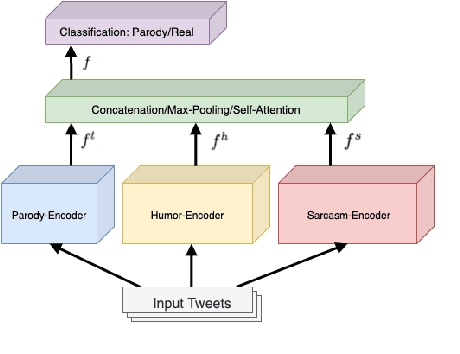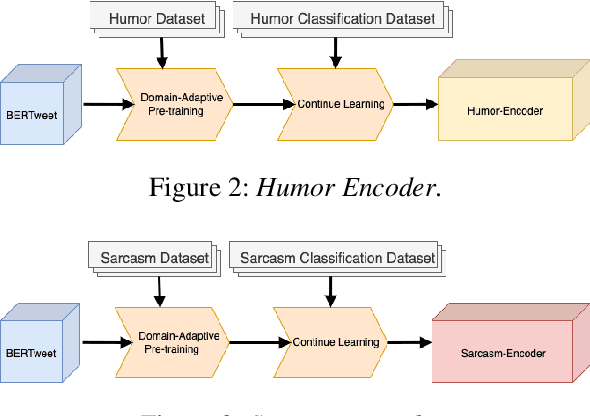Danae Sánchez Villegas
Movie Facts and Fibs (MF$^2$): A Benchmark for Long Movie Understanding
Jun 06, 2025Abstract:Despite recent progress in vision-language models (VLMs), holistic understanding of long-form video content remains a significant challenge, partly due to limitations in current benchmarks. Many focus on peripheral, ``needle-in-a-haystack'' details, encouraging context-insensitive retrieval over deep comprehension. Others rely on large-scale, semi-automatically generated questions (often produced by language models themselves) that are easier for models to answer but fail to reflect genuine understanding. In this paper, we introduce MF$^2$, a new benchmark for evaluating whether models can comprehend, consolidate, and recall key narrative information from full-length movies (50-170 minutes long). MF$^2$ includes over 50 full-length, open-licensed movies, each paired with manually constructed sets of claim pairs -- one true (fact) and one plausible but false (fib), totalling over 850 pairs. These claims target core narrative elements such as character motivations and emotions, causal chains, and event order, and refer to memorable moments that humans can recall without rewatching the movie. Instead of multiple-choice formats, we adopt a binary claim evaluation protocol: for each pair, models must correctly identify both the true and false claims. This reduces biases like answer ordering and enables a more precise assessment of reasoning. Our experiments demonstrate that both open-weight and closed state-of-the-art models fall well short of human performance, underscoring the relative ease of the task for humans and their superior ability to retain and reason over critical narrative information -- an ability current VLMs lack.
MuSeD: A Multimodal Spanish Dataset for Sexism Detection in Social Media Videos
Apr 15, 2025Abstract:Sexism is generally defined as prejudice and discrimination based on sex or gender, affecting every sector of society, from social institutions to relationships and individual behavior. Social media platforms amplify the impact of sexism by conveying discriminatory content not only through text but also across multiple modalities, highlighting the critical need for a multimodal approach to the analysis of sexism online. With the rise of social media platforms where users share short videos, sexism is increasingly spreading through video content. Automatically detecting sexism in videos is a challenging task, as it requires analyzing the combination of verbal, audio, and visual elements to identify sexist content. In this study, (1) we introduce MuSeD, a new Multimodal Spanish dataset for Sexism Detection consisting of $\approx$ 11 hours of videos extracted from TikTok and BitChute; (2) we propose an innovative annotation framework for analyzing the contribution of textual and multimodal labels in the classification of sexist and non-sexist content; and (3) we evaluate a range of large language models (LLMs) and multimodal LLMs on the task of sexism detection. We find that visual information plays a key role in labeling sexist content for both humans and models. Models effectively detect explicit sexism; however, they struggle with implicit cases, such as stereotypes, instances where annotators also show low agreement. This highlights the inherent difficulty of the task, as identifying implicit sexism depends on the social and cultural context.
ImageChain: Advancing Sequential Image-to-Text Reasoning in Multimodal Large Language Models
Feb 26, 2025Abstract:Reasoning over sequences of images remains a challenge for multimodal large language models (MLLMs). While recent models incorporate multi-image data during pre-training, they still struggle to recognize sequential structures, often treating images independently. This work introduces ImageChain, a framework that enhances MLLMs with sequential reasoning capabilities over image data by modeling visual sequences as a multi-turn conversation. In ImageChain, images are interleaved with corresponding textual descriptions to form a controlled dialogue that explicitly captures temporal dependencies and narrative progression. Our method optimizes for the task of next-scene description, where the model generates a context-aware description of an upcoming scene based on preceding visual and textual cues. We demonstrate that our approach improves performance on the next-scene description task -- achieving an average improvement from 3.7% to 19% in SimRate, a metric that quantifies semantic similarity to human-annotated ground truths. Moreover, ImageChain achieves robust zero-shot out-of-domain performance in applications ranging from comics to robotics. Extensive experiments validate that instruction-tuning in a multimodal, multi-turn conversation design is key to bridging the gap between static image understanding and temporally-aware reasoning.
Improving Multimodal Classification of Social Media Posts by Leveraging Image-Text Auxiliary tasks
Sep 14, 2023Abstract:Effectively leveraging multimodal information from social media posts is essential to various downstream tasks such as sentiment analysis, sarcasm detection and hate speech classification. However, combining text and image information is challenging because of the idiosyncratic cross-modal semantics with hidden or complementary information present in matching image-text pairs. In this work, we aim to directly model this by proposing the use of two auxiliary losses jointly with the main task when fine-tuning any pre-trained multimodal model. Image-Text Contrastive (ITC) brings image-text representations of a post closer together and separates them from different posts, capturing underlying dependencies. Image-Text Matching (ITM) facilitates the understanding of semantic correspondence between images and text by penalizing unrelated pairs. We combine these objectives with five multimodal models, demonstrating consistent improvements across four popular social media datasets. Furthermore, through detailed analysis, we shed light on the specific scenarios and cases where each auxiliary task proves to be most effective.
A Multimodal Analysis of Influencer Content on Twitter
Sep 06, 2023Abstract:Influencer marketing involves a wide range of strategies in which brands collaborate with popular content creators (i.e., influencers) to leverage their reach, trust, and impact on their audience to promote and endorse products or services. Because followers of influencers are more likely to buy a product after receiving an authentic product endorsement rather than an explicit direct product promotion, the line between personal opinions and commercial content promotion is frequently blurred. This makes automatic detection of regulatory compliance breaches related to influencer advertising (e.g., misleading advertising or hidden sponsorships) particularly difficult. In this work, we (1) introduce a new Twitter (now X) dataset consisting of 15,998 influencer posts mapped into commercial and non-commercial categories for assisting in the automatic detection of commercial influencer content; (2) experiment with an extensive set of predictive models that combine text and visual information showing that our proposed cross-attention approach outperforms state-of-the-art multimodal models; and (3) conduct a thorough analysis of strengths and limitations of our models. We show that multimodal modeling is useful for identifying commercial posts, reducing the amount of false positives, and capturing relevant context that aids in the discovery of undisclosed commercial posts.
Sheffield's Submission to the AmericasNLP Shared Task on Machine Translation into Indigenous Languages
Jun 16, 2023



Abstract:In this paper we describe the University of Sheffield's submission to the AmericasNLP 2023 Shared Task on Machine Translation into Indigenous Languages which comprises the translation from Spanish to eleven indigenous languages. Our approach consists of extending, training, and ensembling different variations of NLLB-200. We use data provided by the organizers and data from various other sources such as constitutions, handbooks, news articles, and backtranslations generated from monolingual data. On the dev set, our best submission outperforms the baseline by 11% average chrF across all languages, with substantial improvements particularly for Aymara, Guarani and Quechua. On the test set, we achieve the highest average chrF of all the submissions, we rank first in four of the eleven languages, and at least one of our submissions ranks in the top 3 for all languages.
Combining Humor and Sarcasm for Improving Political Parody Detection
May 06, 2022



Abstract:Parody is a figurative device used for mimicking entities for comedic or critical purposes. Parody is intentionally humorous and often involves sarcasm. This paper explores jointly modelling these figurative tropes with the goal of improving performance of political parody detection in tweets. To this end, we present a multi-encoder model that combines three parallel encoders to enrich parody-specific representations with humor and sarcasm information. Experiments on a publicly available data set of political parody tweets demonstrate that our approach outperforms previous state-of-the-art methods.
Point-of-Interest Type Prediction using Text and Images
Sep 01, 2021



Abstract:Point-of-interest (POI) type prediction is the task of inferring the type of a place from where a social media post was shared. Inferring a POI's type is useful for studies in computational social science including sociolinguistics, geosemiotics, and cultural geography, and has applications in geosocial networking technologies such as recommendation and visualization systems. Prior efforts in POI type prediction focus solely on text, without taking visual information into account. However in reality, the variety of modalities, as well as their semiotic relationships with one another, shape communication and interactions in social media. This paper presents a study on POI type prediction using multimodal information from text and images available at posting time. For that purpose, we enrich a currently available data set for POI type prediction with the images that accompany the text messages. Our proposed method extracts relevant information from each modality to effectively capture interactions between text and image achieving a macro F1 of 47.21 across eight categories significantly outperforming the state-of-the-art method for POI type prediction based on text-only methods. Finally, we provide a detailed analysis to shed light on cross-modal interactions and the limitations of our best performing model.
Analyzing Online Political Advertisements
May 26, 2021



Abstract:Online political advertising is a central aspect of modern election campaigning for influencing public opinion. Computational analysis of political ads is of utmost importance in political science to understand the characteristics of digital campaigning. It is also important in computational linguistics to study features of political discourse and communication on a large scale. In this work, we present the first computational study on online political ads with the aim to (1) infer the political ideology of an ad sponsor; and (2) identify whether the sponsor is an official political party or a third-party organization. We develop two new large datasets for the two tasks consisting of ads from the U.S.. Evaluation results show that our approach that combines textual and visual information from pre-trained neural models outperforms a state-of-the-art method for generic commercial ad classification. Finally, we provide an in-depth analysis of the limitations of our best-performing models and linguistic analysis to study the characteristics of political ads discourse.
Point-of-Interest Type Inference from Social Media Text
Oct 02, 2020



Abstract:Physical places help shape how we perceive the experiences we have there. For the first time, we study the relationship between social media text and the type of the place from where it was posted, whether a park, restaurant, or someplace else. To facilitate this, we introduce a novel data set of $\sim$200,000 English tweets published from 2,761 different points-of-interest in the U.S., enriched with place type information. We train classifiers to predict the type of the location a tweet was sent from that reach a macro F1 of 43.67 across eight classes and uncover the linguistic markers associated with each type of place. The ability to predict semantic place information from a tweet has applications in recommendation systems, personalization services and cultural geography.
 Add to Chrome
Add to Chrome Add to Firefox
Add to Firefox Add to Edge
Add to Edge